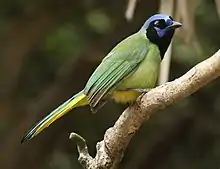| Green jay | |
|---|---|
 | |
| A green jay in Texas | |
| Scientific classification | |
| Domain: | Eukaryota |
| Kingdom: | Animalia |
| Phylum: | Chordata |
| Class: | Aves |
| Order: | Passeriformes |
| Family: | Corvidae |
| Genus: | Cyanocorax |
| Species: | C. luxuosus |
| Binomial name | |
| Cyanocorax luxuosus (Lesson, RP, 1839) | |
 | |
The green jay (Cyanocorax luxuosus) is a species of the New World jays, and is found in Central America. Adults are about 27 cm (11 in) long and variable in colour across their range; they usually have blue and black heads, green wings and mantle, bluish-green tails, black bills, yellow or brown eye rings, and dark legs. The basic diet consists of arthropods, vertebrates, seeds, and fruit. The nest is usually built in a thorny bush; the female incubates the clutch of three to five eggs. This is a common species of jay with a wide range and the International Union for Conservation of Nature has rated its conservation status as being of "least concern".
Taxonomy

Some ornithologists treat the green jay as conspecific with the Inca jay of the Andes, with C. yncas luxuosus as the green jay and C. yncas yncas as the Inca jay.[2][3]
Description
Green jays are 25–29 cm (9.8–11.4 in) in length. Weight ranges from 66 to 110 grams (2.3 to 3.9 oz).[4] They have feathers of yellowish-white with blue tips on the top of the head, cheeks and nape, though some taxa have more blue than others. The breast and underparts range from bright yellow in the south to pale green in the north (e.g., Texas). The upper parts are rich green. It has large nasal bristles that form a distinct tuft in some subspecies, but are less developed in others. The color of the iris ranges from dark brownish to bright yellow depending on the subspecies.
Behavior
Green jays feed on a wide range of insects and other invertebrates and various cereal grains. They take ebony (Ebenopsis spp.) seeds where these occur, and also any oak species' acorns, which they will cache. Meat and human scraps add to the diet when opportunity arises. Green jays have been observed using sticks as tools to extract insects from tree bark.[5]
Breeding
Green jays usually build a nest in a tree or in a thorny bush or thicket, and the female lays three to five eggs. Only the female incubates, but both parents take care of the young.[4]
Voice
As with most of the typical jays, this species has a very extensive voice repertoire. The bird's most common call makes a rassh-rassh-rassh sound, but many other unusual notes also occur. One of the most distinctive calls sounds like an alarm bell.
Distribution and habitat
The green jay occurs from southern Texas to Honduras. The similar Inca jay has a disjunct home range in the northern Andes of South America.
Status
The green jay is a common species throughout most of its wide range. It is an adaptable species and the population is thought to be increasing as clearing of forests is creating new areas of suitable habitat. No particular threats have been identified, and the International Union for Conservation of Nature has rated its conservation status as being of "least concern".[1]
References
- 1 2 BirdLife International (2012). "Cyanocorax luxosus". IUCN Red List of Threatened Species. 2012. Retrieved 26 November 2013.
- ↑ dos Anjos, L. (2018). del Hoyo, J.; Elliott, A.; Sargatal, J.; Christie, D.A.; de Juana, E. (eds.). "Green Jay (Cyanocorax yncas)". Handbook of the Birds of the World Alive. Lynx Edicions. Retrieved 16 May 2018.
- ↑ Dickinson, E.C.; Christidis, L., eds. (2014). The Howard & Moore Complete Checklist of the Birds of the World. Vol. 2: Passerines (4th ed.). Eastbourne, UK: Aves Press. pp. 240–241. ISBN 978-0-9568611-2-2.
- 1 2 "Green jay". All About Birds. Cornell Lab of Ornithology. Retrieved 20 March 2013.
- ↑ Gayou, Douglas C. (1982). "General Notes: Tool use by Green Jays" (PDF). Wilson Bulletin. 94 (4): 593–594.
External links
- Green jay stamps from Belize and Venezuela at bird-stamps.org
- BirdLife species factsheet for Cyanocorax yncas
- "Cyanocorax yncas". Avibase.
- "Green jay media". Internet Bird Collection.
- Green jay photo gallery at VIREO (Drexel University)
- Green jay species account at Neotropical Birds (Cornell Lab of Ornithology)
- Interactive range map of Cyanocorax yncas at IUCN Red List maps
- Audio recordings of Green jay on Xeno-canto.
- Cyanocorax yncas in Field Guide: Birds of the World on Flickr
